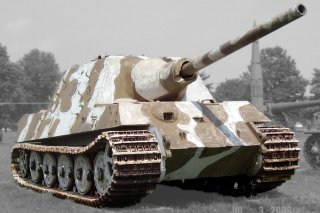Nazi Germany's Jagdtiger Tank: Killing Machine or Big, Fat Mistake?
Sure the Jagdtiger had impressive firepower, but it was too huge and prone to breakdown to be worth the cost.
However, as German forces became trapped in the so-called Ruhr pocket, the Jagdtigers finally began fighting the kind of battles they were designed for. At Herborn, Ernst’s company claimed to have destroyed thirty Sherman tanks with shots from two miles away. Then, on April 8,, Carius’s Second Company deployed in ambush position at Unna and reported knocking out twenty Shermans and armored cars for the loss of a single vehicle.
Ernst’s remaining four Jagdtigers were reinforced by a platoon each of Panzer IV medium tanks, Stug IV assault guns and Sd.Kfz. 7/2 self-propelled flak guns. On April 11 these deployed to a ridge overlooking the road to Langschede. When an American column from the Eighth Division came rolling through the valley below them, Ernst’s battlegroup unleashed a hail of armor piercing shells, knocking out eleven Shermans and forty more vehicles. The American column fell back in panic—and called in air support. Three waves of P-47s swooped down lew up a Jagdtiger and a flak-track—but flak shells and machine guns caused two of the jug-shaped fighters to crash in flames.
An important caveat is that the German claims were likely in excess of actual Allied losses, as tankers on all sides tended to overclaim. However, this battlefield appears to be described by British officer George Forty in his book German Tanks of World War II:
“I remember vividly coming across what seemed to be an entire regiment of Sherman tanks which had been completely annihilated. There were Shermans lying in heaps everywhere one looked, turrets blown off, hulls ripped apart, most had clearly been brewed up. . . . They had been advancing with the grain of the country and had clearly been taken by surprise from a flank. The follow-up echelon had then turned right-handed towards their tormentor, but had found little cover along their new line of advance. The author of all this carnage was one single Jagdtiger, whose immense bulk still occupied a perfect fire position in a farmyard at the top of a commanding hill feature.”
So Jagdtigers could live up to their intimidating reputation on the rare occasions they were able to deploy into good ambush positions miles away from enemy forces, allowing them to take full advantage of their oversized guns and minimize exposure to flank attacks. But the reichsmarks and man-hours necessary to build a single Jagdtiger could have produced an entire platoon Panthers or Jagdpanthers, which were nearly as effective in most circumstances and less likely to break down. A malfunctioning, fuel-devouring super tank hardly benefited a desperate Nazi Germany.
Between April 12 and 15, Ernst’s Jagdtigers continued to disrupt poorly coordinated U.S. advances with long-range fires, knocking out at least four more Shermans—while being forced to scuttle six more broken-down Jagdtigers. However, as German positions collapsed, Captain Ernst was left the ranking officer in the region.
Wishing to spare refugee-packed Iserlohn from destruction, Ernst met with Lt. Col. Robert Kriz of the U.S. Ninety-Ninth Infantry Division on April 16 to arrange the surrender of German forces in the pocket.
It’s a fitting irony that the best recorded footage of the humongous tank destroyers was filmed as Ernst’s last three Jagdtigers rolled in an orderly formation into Iserlohn’s Schiller Square before assembled American troops and local civilians. This dignified act of surrender was arguably the finest moment of a beastly weapon of war.
Sébastien Roblin holds a master’s degree in conflict resolution from Georgetown University and served as a university instructor for the Peace Corps in China. He has also worked in education, editing and refugee resettlement in France and the United States. He currently writes on security and military history for War Is Boring. This piece was originally featured in April 2018 and is being republished due to reader's interest.
Image: Jagdpanzer VI Jagdtiger on display at the US Army Ordnance Museum in Aberdeen. The picture taken July 3, 2006. Wikimedia/Fat yankey. Creative Commons Attribution-ShareAlike 2.5 Generic (CC BY-SA 2.5) license.
Recommended: The 5 Biggest Nuclear Bomb Tests (From All 6 Nuclear Powers).
Recommended: How Israel Takes U.S. Weapons and Makes Them Better.
Recommended: North Korea’s Most Lethal Weapon Isn’t Nukes.

